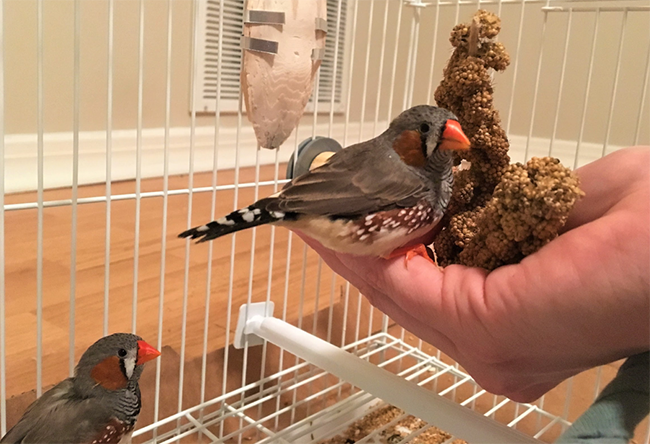Home » News » Building the smallest recording studio in Nashville
Building the smallest recording studio in Nashville
Posted by anderc8 on Monday, April 2, 2018 in News, TIPs 2015.
Written by Kate T. Snyder, PhD Candidate in Biological Sciences, Graduate Researcher advised by Dr. Nicole Creanza
Watch video about the songbirds
When springtime finally arrives in Nashville, our city becomes even more musical. I’m not referring to the upcoming concerts in the park or downtown by the river, though. For the past month or so, as the trees have regained their leaves, birds have returned from their winter roosts, bringing with them their songs.
Music is in many ways a uniquely human behavior. Certainly, no other species engages in the behavior of creating sound with as much variety, complexity and ubiquity as people do. Still, when we break down music to essential components such as rhythm and pitch, we find many musical creatures in the natural world, including bats, whales and especially songbirds.
How did an animal that is more closely related to Tyrannosaurus rex than to Taylor Swift become so apparently musical that “song” became part of their name? Why do our own brains respond so powerfully to music? Are the answers to these questions linked?
It turns out, “bird brains” have surprising similarities to those of humans. One major similarity is found in the neural processes related to the perception and production of song. Both songbirds and humans listen to their own voices and compare their actual output to the sounds they were trying to produce, essentially allowing them to “edit” their vocalizations as they practice. Importantly, this neural process enables vocally mimicking sounds. While a great many animals learn different behaviors – think lion cubs learning to hunt, or lab mice finding food in a maze – this mimicking, or vocal learning, is otherwise exceedingly rare in the animal kingdom.
In other words, you can teach your dog to sit, and you can teach your dog to “speak,” but even the smartest dog will never learn to tell you to sit. Dogs, like most animals, do not learn their vocalizations from others, so are neurologically incapable of learning spoken language, even if they would otherwise be physically capable of speech.
Songbirds are different. While they also have unlearned vocalizations, such as some of their simpler sounds, referred to as “calls,” they do not hatch knowing their species’ songs. Instead, these are learned during development by listening to adults around them sing, then practicing those songs until they match them in pitch, tone, note spacing, and rhythm. When they start learning, their vocalizations, known as “subsong,” sound like arrhythmic, uncoordinated noise which gets progressively more refined as they gain practice. This process parallels what we humans experience as infants, first babbling as we attempt to recreate the phonemes of our cultural environment and eventually producing articulate sounds that we organize into speech.
So, why research songbirds? We are interested in the development and nuance of spoken language, from the neural mechanisms of sound integration to the development of prosody. Songbirds are the ideal animal model to investigate the origins of these vocal behavioral traits. Further, researchers can use songbirds to gain insight into the causes of certain speech disorders, since pathologies such as stuttering and impaired auditory processing can be observed and induced in songbirds.
In our lab, we study zebra finches to learn more about song development in juveniles. Zebra finches are excellent for this line of research for several reasons. First, juveniles (“pupils”) attempt to mimic their adult “tutor” as closely as possible, so we can quantify how well they learned by computationally analyzing the differences between their song and their tutor’s. Second, they sing only one song as adults, simplifying the analysis. Third, they learn only until they are about 90 days post-hatching, after which point, they will not alter their song. This allows us to track their full song development, from subsong to song crystallization.
There are a few unique problems we must solve in order to conduct this research. We must ensure that the pupil hears only their tutor’s song during the critical learning period, to the exclusion of all other adult tutors and other pupils. Further, we must be confident that, out of 24 pupils and their tutors in one room, our microphones only pick up the individual bird each is targeting. In addition to sound isolation, we must ensure that we are capturing a clear and accurate auditory profile of the juvenile songs by reducing reverberations in the recording environment.

Kate Snyder shows off the finch recording studios.
Essentially, we must build the smallest recording studio in Nashville. With the support of Vanderbilt’s Program for Music, Mind & Society, we are currently building two dozen miniature recording studios to track the vocal development of individual zebra finches. Each bird has his own microphone in a sound-attenuating enclosure, and computers automatically turn on a recording device when the bird breaks into song. The Program for Music, Mind & Society supports our studies by facilitating interdisciplinary work across campus, connecting us to researchers who study music, learning and behavior from numerous perspectives. This will help us bridge the gap between the fascinating ecology, evolution and physiology of bird song and the impactful research in human language development happening at Vanderbilt, perhaps pushing us into a new frontier of the science of vocal learning.
We’d love to hear your observations about birds in Music City! What bird songs have you been noticing this season? Can nonhuman animals be truly musical? Do music industry folks have any tips for first-time “studio” architects? Let us know in the comments section below!
3 Comments on “Building the smallest recording studio in Nashville”
Steve Baskauf on April 3rd, 2018 at 10:35 am
Yesterday I enjoyed hearing the repeated calls of a broad-winged hawk near our field site in Warner Parks. I tried to listen carefully to make sure I wasn’t being fooled by a blue jay mimic!
david parsley on April 5th, 2018 at 1:56 pm
What a great description of your research. I am curious if you know of any researchers working on bird hearing, not singing? As you may know, some bird species have the ability to repair stereocilia, which would be a neat trick if humans could! Oh, yes, I’ve been listening to six sparrow species during this spring’s migration!
Film streaming vf on November 1st, 2018 at 4:10 pm
wow congrats for the studio


